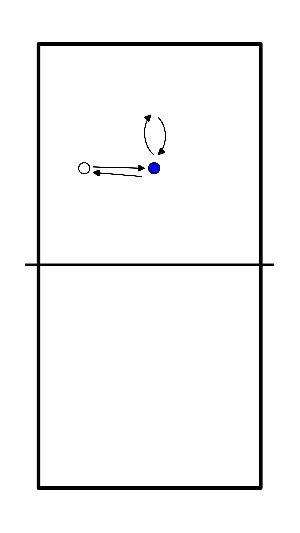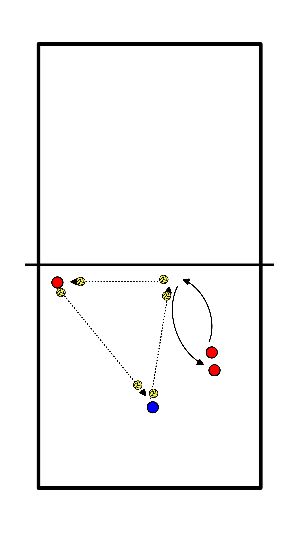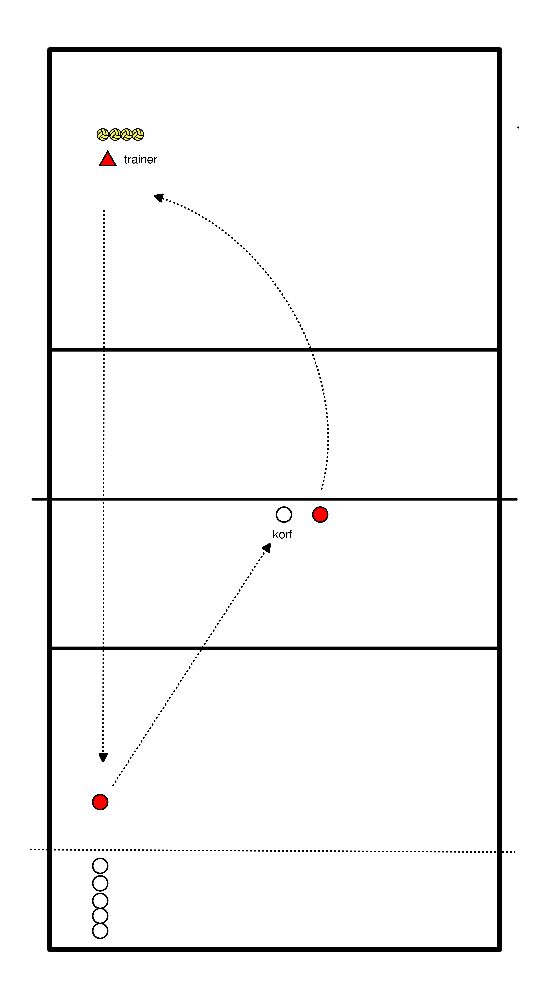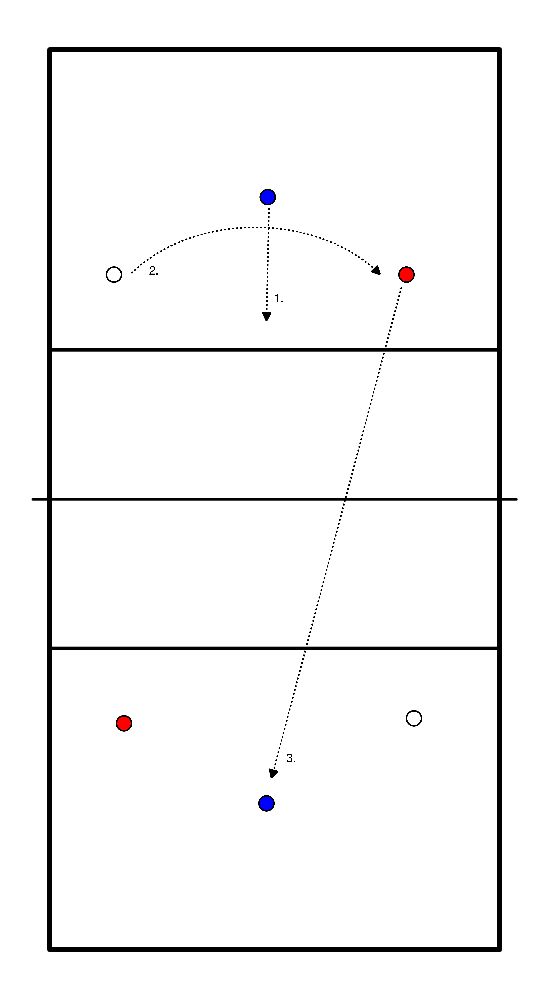Volleyball exercises for u13
Organization:
- Players in a row on p1
- Trainer with ball pit on p2
Execution:
- Trainer throws balls in an arc in the middle of the field.
- Players must:
- Catch and pass the ball and throw it in the ballcage.
- Turn to p1 and catch at belly height.
- Make a turn in the run and catch the ball
- Sprint from lying position to the ball and catch it
- At the place where the ball is going to fall, lie down and let the ball bounce on your back
- Divide the team in pairs.
- Player 1 stands on the backline of the court and player 2 stands on a random spot on the other side of the net.
- The intention is that player 1 serves the ball into the hands of player 2.
- Player 2 is not allowed to step aside. If player 1 serves underarm into the hands of player 2 he gets 1 point.
- Overhand? --> 2 points.
- Change after 10 balls.
- The team with the most points wins.
- Player starts on the backline (C and higher)
- or behind the middle (CMV).
- Trainer serves high over the net
- Player runs as fast as possible and tries to catch
- Run back around the outside
- Per person 2 balls
- One ball between the legs/under the arm, other in two hands on a side of choice, throw ball straight up and catch with two hands
- When the ball is up on one side, throw the other ball up on the other side.
- Keep arms straight, throw as much as possible straight up
- Pairs 2 balls.
- One person throws a ball straight to the other person
- Meanwhile the other person throws his ball straight up and throws it back.
- Then catch your own ball

- 1 player at pos 5 throws in the ball to pos 3 (SV).
- 2 players take turns to walk in from pos 1 to pos 3 (SV).
- From here they take care of the setup to pos 4.
- At pos 4, one player stands on an elevation (e.g. plinth/cabinet) to catch the ball and pass it to pos 5.
https://www.youtube.com/watch?v=_qQZSwT531Y

- Half of the team lined up at position 2.
- Other half of the team with ball at position 5.
- Just start throwing in and chasing the ball.
- Extend with passing at position 5 and overhand at position 2.
- Then expand further by adding exercises like blocking at the net, diving etc.
- 1 player at position 2.
- 1 player on position 3.
- Coach or player on position 4.
- Rest of the players in a line behind the back line at position 1.
- Player at position 2 throws a deep ball.
- Player passes back.
- Player at position 3 throws a short ball inside the three meter line.
- Player passes back ball.
- Player/coach at position 4 hits or throws a deep ball.
- Player passes it back and joins the back of the row again.
- Don't forget to pass regularly!
- Coach stands in the middle by the net.
- Line of three players stand behind the back line.
- Trainer throws balls alternately to the right and then to the left.
- Players start walking in circles because they are in threes.
- Players who are not in line are collecting balls.
- Code warm-up game.
- You make 2 or 3 groups.
- You come up with a code of about 8 numbers. {depending on the condition of the team}
- Say my code is 11325543.
- 1- 2 x run to the net and back.
- 2- 5x abs.
- 3- 5 times blocking.
- 4- 2 x dive.
- 5- 20 seconds in sitting position against the wall.
- The pair tries to decipher the code.
- They do 1 of the 5 exercises, then come to the trainer to see if the number is correct.
- If yes:
- May they try to guess the next one.
- If no:
- They have to choose another number to guess the code.
- Who deciphers the code first, wins.
- Trainer throws-serves ball to passer.
- A passes ball to midfield position.
- B stands at the basket and catches the ball and brings it to the trainer and then joins the back of the line.
- A becomes B.

- Explanation:
- 2 teams of 3 players
- Per team 3 volleyballs (different balls so you can tell the difference, 2 'baby' and 1 'normal' ball)
- The team must play the 'normal' ball over the net in 3 times and meanwhile the 'babies' are thrown over.
- Each player may only touch the 'normal' ball once!
- (When a player has played the 'regular' ball, he gets a 'baby' thrown to him)
- Starting positions:
- Mid-back has no ball. Mid-back has no ball (he passes the ball to the distributor).
- Distributor gives a set-up on the outside.
- 3rd player plays the ball over the net. (At first do not attack, only if it goes well!)

- The goal is to play the ball in threes. This requires the commitment of every player.
- So line up three players.
- They solve a thrown ball (by the trainer), by playing in threes.
- The first ball is passed to the upper-position.
- The 2nd player, who has the job of upper-player, runs to the upper-place.
- The 3rd player then prepares for the attack.
- At first keep the ball on one side of the net, by not actually hitting the 3rd ball, but catching it.
- Then 3 other players move in to do the same.
- On the other side of the net, the same is practiced with the other half of the team.
- After a while, when the ball is regularly played in threes, the ball is actually played to the other side.
- The team on the other side then plays the ball back in threes.
- And so on; play over as long as possible.
- No scoring, it's about playing in threes.








